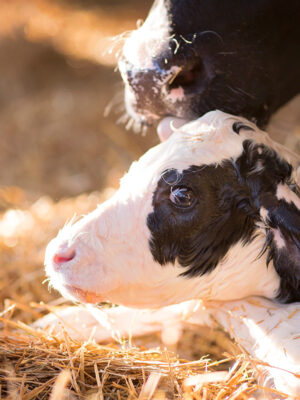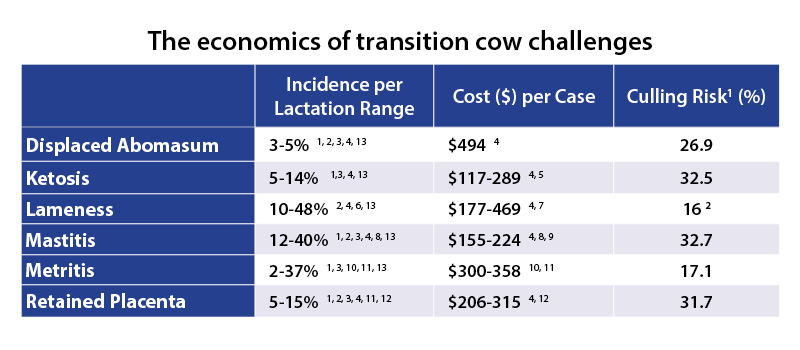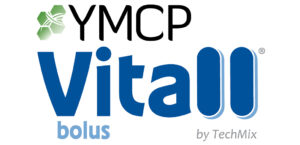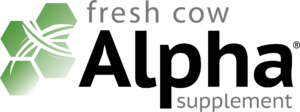Key fresh cow challenges
For the fresh cow, the entire transition period is really a series of one stress event followed by another. From decreased dry matter intake close up, to challenges with rehydration and re-establishment of feed intake post-freshening, the dairyman needs solutions that encourage a healthy recovery and optimal lactation performance.
Many fresh cow challenges can be mitigated with proper nutrition delivered at just the right time.
It is important to understand the most common freshening challenges and introduce timely nutritional solutions proven to help the post-fresh cow recover quickly while demonstrating solid economic benefits to the dairy producer. Prevent fresh cow troubles before clinical symptoms of disease show up.

Phase 1: Pre-Freshening
When cows freshen, their feed intake drops up to 25% in the first 24-48 hours after calving. However, research shows that feed intake drops significantly in close-up cows. Combined, this reduction in feed intake puts the cow at a significant post-freshening nutritional disadvantage heading into lactation where her nutritional demands are great.
Due to the large amount of physical and nutritional stress put on the fresh cow, there are many physical and metabolic challenges that can be triggered. The most common challenges may include the following: hypocalcemia, metritis, dehydration, ketosis, retained placenta, milk fever and displaced abomasum.
Phase 2: Freshening
Hypocalcemia (low blood calcium)
Every new lactation tests the cow’s ability to maintain adequate blood calcium levels. Healthy cows have 10-12 grams calcium in their blood but producing milk requires significant amounts of calcium which the cow needs to accommodate. Colostrum production alone demands 20-30 grams of calcium in the first day. It’s clear that the physical demands for supplemental calcium are significant.

Blood calcium is required for normal muscle and nerve function – especially as it relates to strength and gastrointestinal motility. Cows that do not have adequate amounts of calcium can readily be challenged with hypocalcemia. According to research 10-20% of multiparous cows are clinically hypocalcemic at freshening; another 50% can be considered subclinical.
The physiology of hypocalcemia
The beginning of lactation challenges the calcium balance in the cow. Due to colostrum and milk being very high in calcium the cow’s body pulls milk from those sources to compensate. This activity causes a negative calcium balance within the cow that continues for roughly the first 90 days of lactation.
Subclinical hypocalcemia means a cow has low blood calcium levels without the symptoms of clinical milk fever. Due to the symptoms being undetected, the economic losses of subclinical hypocalcemia far exceed the costs associated with milk fever.
Subclinical hypocalcemia has greater treatment and production costs than clinical cases of milk fever!
Phase 3: Post-Freshening
Negative Energy Balance
When energy intake is less than energy used for milk production and cow maintenance, a cow can fall into a negative energy state. There are many factors that affect cow’s energy levels; hormonal changes, and low dry matter intake are a few that increase negative energy.
Proper nutrition is critical to the recovery of fresh cows. The quicker she gets back on full feed, the better chance she has for a full recovery.
Dehydration
Research shows that water intake helps improve feed intake. However prior to freshening, feed and water intake are both shown to decline leaving the cow somewhat dehydrated even before she freshens. Studies have shown, during this time up to 14 gallons of extracellular fluids are lost. Add this to the fact that fluid and tissue loss during freshening can equal the weight of the calf and she now has an immediate demand to produce milk.

Identifying levels of dehydration
Severely challenged cattle can dehydrate in excess of 10% of their body weight. This degree of dehydration is potentially life threatening and clinical signs include the following:
- Eyes sunken into orbits
- Skin remains tented indefinitely
- Mucus membranes are dry
- Depressed attitude is evident
Cattle with dehydration 5-10% of their body weight will exhibit:
- Partial sunken eyes into the orbit
- Skin tenting that is 4 to 8 seconds in duration
- Tacky mucus membranes
- Reduced dry matter intake
- Decreased productivity
It should be noted that university studies indicate cattle with 7-8% dehydration levels show impaired immune response.
Cattle with 2 – 4 percent dehydration or less will have minimal observable clinical signs but physiological and performance efficiency can be reduced.
Water loss during heat stress can be quite evident by observing the cows body condition. But even in periods when heat stress is not a factor maintaining proper hydration is important as cows continually lose water via:
- Milk production (25-35% of total water intake)
- Freshening (fluid loss equal in weight to the calf)
- Fecal (30-35% of total water intake)
- Urine (15-21% of total water intake)
- Vapor loss from the lungs
- Digestion
- Disease, diarrhea, malabsorption
economic impact
The transition period should be the pinnacle of a dairyman’s focus, because any miscalculation here can cost thousands in either health related issues or long-term production losses. In fact, 70-80% of veterinary costs are incurred 1-3 weeks post-freshening. With proper understanding of the relationship between fresh cow physiology and proper nutrition, a dairy farmer can save significantly on treatment interventions, culling or lost production. The table below, highlights some of the key post-freshening challenges and associated treatment costs.

The above chart references monetary value in U.S. dollars.
1 Grohn, Y. et al. 1998. Effect of Diseases on the Culling of Holstein Dairy Cows in New York State. J. of Dairy Sci, 81(4):966-978.
2 USDA. 2008. Dairy 2007, Part II: Changes in the U.S. Dairy Cattle Industry, 1991–2007 USDA-APHIS-VS, CEAH. FortCollins, CO #N481.0311. 3 Bar, D., et al. 2007. Effect of repeated episodes of generic clinical mastitis on milk yield in dairy cows. Journal of dairy science 90(10):4643-4653. 4 Guard, C. 2009. The costs of common diseases of dairy cattle. Central Veterinary Conference Proceedings. Kansas City, MO..
5 McArt, J.A. et al, 2015. Hyperketonemia in early lactation dairy cattle: a deterministic estimate of component and total cost per case. J. of Dairy Sci.98(3):2043-2054.
e Bicalho, R.C. Lameness in Dairy Cattle: A debilitating disease or a Disease of Debilitated Cattle? Western Dairy Management Conference, 2011. Pg 73-83.
7 Cha, E. et al. 2010. The cost of different types of lameness in dairy cows calculated by dynamic programming. Preventive veterinary medicine 97(1):1-8.
8 Cha, E, et al. 2014. Optimal insemination and replacement decisions to minimize the cost of pathogen-specific clinical mastitis in dairy cows. Journal of dairy science 97(4):2101-2117.
9 Cha, E, et al. 2011. The cost and management of different types of clinical mastitis in dairy cows estimated by dynamic programming. Journal of dairy science94(9):4476-4487.
10 Overton, M. and J. Fetrow. 2008. Economics of postpartum uterine health. Proc Dairy Cattle Reproduction Council:39-44.
11 “The Value of Uterine Health: the diseases, the causes, and the financial implications.” Dairy Cattle Reproduction Council article.
12 Guard, C., 1999. Retained Placenta: Causes and Treatments. Advances in Dairy Technology (1999) Vol. 11, page 81.
13 Zwald, N.R., K.A. Weigel, Y.M. Chang, R.D. Welper and J.S. Clay. 2004. Genetic selection of Health Traits using Producer-Recorded Data. I. Incidence Rates, Heritability Estimates and Sire Breeding Values. J. of Dairy Sci., 87:4287-4294.
Fresh Cow Program
Our Fresh Cow Program provides the nutrients required for post-freshening recovery into lactation – the right nutrition at the right time™.
These products have become the nutrition cornerstone for fresh cow groups around the world. Each is formulated to specifically address nutrition needs at very specific points during transition. This product grouping is considered the fresh cow protocol, and recommended for use on every fresh cow.


